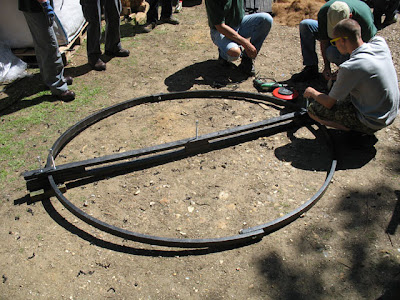 Although the Little Ringed Plovers that lost their brood at the Tern hide still think there is enough summer to start another nesting attempt, there are distinct signs of approaching autumn. 2 Common Sandpipers on the trees outside the Ivy South hide were already on their way south after breeding. On Ibsley Water the geese are in full wing moult and the air is full of fledgling Black-headed Gulls.
Although the Little Ringed Plovers that lost their brood at the Tern hide still think there is enough summer to start another nesting attempt, there are distinct signs of approaching autumn. 2 Common Sandpipers on the trees outside the Ivy South hide were already on their way south after breeding. On Ibsley Water the geese are in full wing moult and the air is full of fledgling Black-headed Gulls.Although Blashford cannot claim to be a great site for orchids we do have some, the willow woodland in some areas have lots of Broad-leaved Helleborine, they flower mostly in July so are not out yet. The one pictured should have a good stem of flowers, I will add a picture of it if it does, I put it in now because they often get nibbled down by Rabbits, so they often don't get to flower.
 Another orchid we have and one that is in full flower now is the Bee Orchid. They are scattered around the area of the reserve north of Ellingham Drove, the one below was beside the path to the Lapwing hide.
Another orchid we have and one that is in full flower now is the Bee Orchid. They are scattered around the area of the reserve north of Ellingham Drove, the one below was beside the path to the Lapwing hide. I spent a good bit of time this morning removing Ragwort from the shore of Ibsley Water, not great for birding but I did see a few butterflies, including a Painted Lady, Small Tortoiseshell, Large White and several Meadow Brown. During the afternoon, I resisted the temptation to continue with the Ragwort and cleared some path sides, this gave further butterflies watching opportunities including my first Silver-washed Fritillary, Small Skipper and Ringlet of the year. There were also several summer brood Comma sunning themselves on the paths.
I spent a good bit of time this morning removing Ragwort from the shore of Ibsley Water, not great for birding but I did see a few butterflies, including a Painted Lady, Small Tortoiseshell, Large White and several Meadow Brown. During the afternoon, I resisted the temptation to continue with the Ragwort and cleared some path sides, this gave further butterflies watching opportunities including my first Silver-washed Fritillary, Small Skipper and Ringlet of the year. There were also several summer brood Comma sunning themselves on the paths.






 Of course we had to check if the raft would actually float so we carried two completed ones to water, luckily they did.
Of course we had to check if the raft would actually float so we carried two completed ones to water, luckily they did.






















-of-White-Ermine.jpg)









